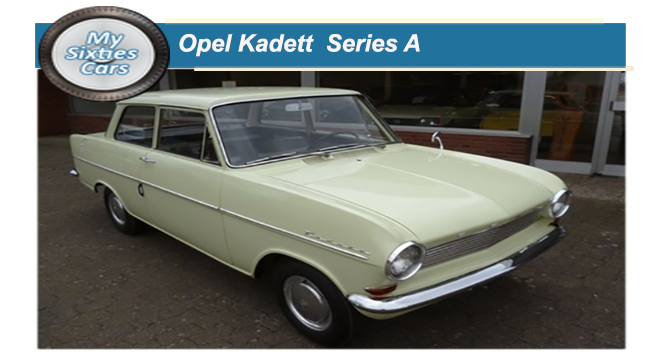
After a gap of more than two decades, in 1962 Opel reinstated their entry-level sedan, the Kadett.
Like some of their larger models, the Opel Kadett A was available in a relatively standard format of two-door saloon, two-door coupe and three-door estate versions, not so subtly titled the "Car-A-Van." Apparently,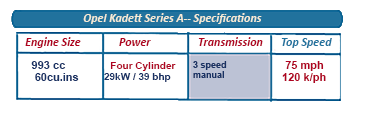 the reason why Opel failed to introduce a compact during the Fifties was that the company had more or less convinced themselves that they had little chance in competing against the Volkswagen Beetle- and probably rightly so.
As the end of the decade approached, Karl Stief product director at Opel, was handed a hot potato by parent company GM in Detroit- to develop a model that would make some inroads into the Beetle’s immense market share.
To put their money where their mouth was, GM announced that they would be building a massive new plant in Bochum to handle the mass production of the new Kadett A compact.
Stief had at
the reason why Opel failed to introduce a compact during the Fifties was that the company had more or less convinced themselves that they had little chance in competing against the Volkswagen Beetle- and probably rightly so.
As the end of the decade approached, Karl Stief product director at Opel, was handed a hot potato by parent company GM in Detroit- to develop a model that would make some inroads into the Beetle’s immense market share.
To put their money where their mouth was, GM announced that they would be building a massive new plant in Bochum to handle the mass production of the new Kadett A compact.
Stief had at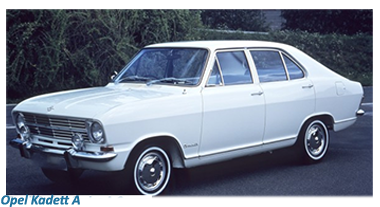 least a minor head start in that he share the development costs with GM’s UK subsidiary Vauxhall who was developing the Viva HA, an entry-level model for their domestic market.
This cooperation format proved to be a success and would set the course for long-term cooperation that lasted for decades.
The Kadett A was powered by a “no-frills” four-cylinder, 993 cm water-cooled Opel overhead valve engine - the first to be developed by Opel since the late Thirties.
least a minor head start in that he share the development costs with GM’s UK subsidiary Vauxhall who was developing the Viva HA, an entry-level model for their domestic market.
This cooperation format proved to be a success and would set the course for long-term cooperation that lasted for decades.
The Kadett A was powered by a “no-frills” four-cylinder, 993 cm water-cooled Opel overhead valve engine - the first to be developed by Opel since the late Thirties.
![]()
Opel initially released the Kadett A with their entry-level engine - the standard 1.0-litre engine with its maximum output listed as 39bhp.
Late in 1963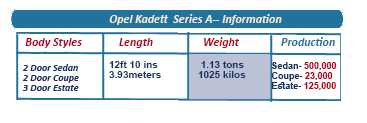 a high compression version the "1.0 S " was introduced, with the same 993 cc capacity, although capable of generating up to 48 bhp thanks to modifications to the camshaft, cylinders and inlet manifold.
a high compression version the "1.0 S " was introduced, with the same 993 cc capacity, although capable of generating up to 48 bhp thanks to modifications to the camshaft, cylinders and inlet manifold.
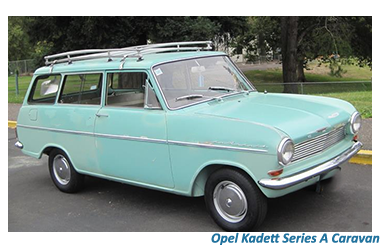 Irrespective of engine size, the Opel Rekord A came fitted with a four-speed gearbox, all-synchromesh, with gear changes made through a floor mounted gear lever.
While it may have been on par technically with the Beetle, as far as design and passenger comfort the Opel Kadett A was way ahead, with a design that was made in the Sixties while the Volkswagen’s design went back to the dark days of the Thirties.
In addition, the Kadett provided as much more in terms of passenger comfort, leg and headroom, improved visibility for the driver and passengers and infinitely more luggage capacity.
Another plus with the Kadett A was, thanks to its engine being water-cooled, drivers and their passengers were much better insulated against the bitingly cold West German winters.
Irrespective of engine size, the Opel Rekord A came fitted with a four-speed gearbox, all-synchromesh, with gear changes made through a floor mounted gear lever.
While it may have been on par technically with the Beetle, as far as design and passenger comfort the Opel Kadett A was way ahead, with a design that was made in the Sixties while the Volkswagen’s design went back to the dark days of the Thirties.
In addition, the Kadett provided as much more in terms of passenger comfort, leg and headroom, improved visibility for the driver and passengers and infinitely more luggage capacity.
Another plus with the Kadett A was, thanks to its engine being water-cooled, drivers and their passengers were much better insulated against the bitingly cold West German winters.






